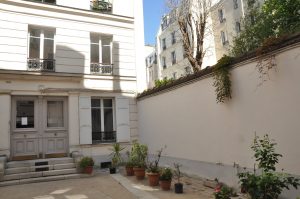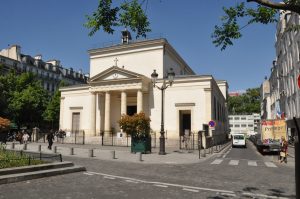What good American doesn’t dream of a pied à terre in Paris, especially now that we have elected Donald Trump president, lying, ignorant bully that he is, and the French opted for the rational and articulate Emmanuel Macron over harridan of the Far Right, Marine Le Pen?
Not that real estate is cheap. We perused the offerings displayed by several agents immobilier as we wandered and it looks like 300 to 800 thousand euros will get us somewhere between 35 and 50 square meters of living space. That would be 40 to 60 square meters of heaven.
89 rue Legendre, in the 17th arrondissement, is a cozy space on the first floor of a nineteenth century building set back from the street in a quiet courtyard. A comfortable bedroom, a spacious living room with a fantastic flat-screen television and an extremely generous cable subscription, a cramped but well-lit and well-appointed kitchen and modern bathroom, have been put at our disposal for a mere 1200 euros for 14 days. It’s still off season and that is less than 100 dollars a day.
Step out the door and it is shopper’s heaven. Around the corner on Avenue de Clichy is a slightly depressed but very useful Super U, a sort of shabby, Walmart-esque store that covers all the basics. For your meat, fruit and veg, wine, olive oil, cheese, charcuterie and all things comestible, explore rue Legendre and walk the half mile or so to rue Levis. Rue Cler in the 7eme is more famous than rue Levis; Rick Steves (and why, I wonder, is so smarmy a phony so darned popular?) rhapsodizes about it and tourists put it on the itinerary. Rue Levis is every bit as wonderful, maybe better, and the neighborhood, a genuine Parisian community, attracts far fewer tourists.
Batignolles is where Edouard Manet had his studio and where the young Turks who became the Impressionists gathered at the Café Guerbois to argue about art, find girls and drink. It’s downhill and west of the Butte Montmartre, just inside the periphérique, the beltway of Paris. It’s a distance from the Seine and ancient and trendy districts like the Marais and the aristocratic boulevards of St. Germain-des-Pres and the Faubourg St. Honoré. Prior to World War I, it was remote and low rent, in Parisian terms. Today some still seem to think it’s remote, but it’s hoppin’ with twenty-somethings, families, elders and immigrants.
And food. Did I mention that there is food and drink, sweets and savories, the fragrant, pungent and spicy everywhere?
I am ecstatic. I want to stay.
That wit and rogue Oscar Wilde (1854-1900) wrote, in his novel The Portrait of Dorian Gray, “When good Americans die, they go to Paris.” Wilde, who some Brits did not consider a model citizen, himself went to Paris when he died. Well, he died in Paris and is buried in Père Lachaise Cemetery under a stone carved by the American sculptor Jacob Epstein (1880-1959) that is embellished with the countless lipstick kisses of adoring fans.
The follow-up question was inevitable: “Where do bad Americans go?”
“They stay in America.”




